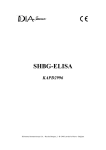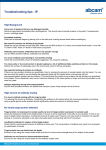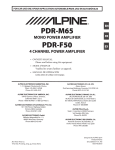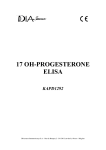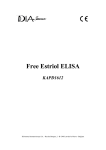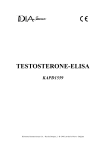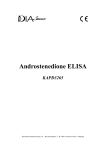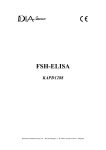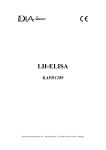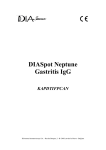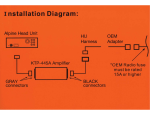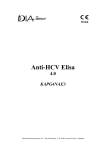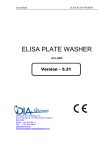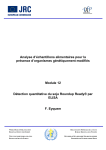Download SHBG-ELISA - BTC Lab website
Transcript
SHBG-ELISA KAPD2996 DIAsource ImmunoAssays S.A. - Rue du Bosquet, 2 - B-1348 Louvain-la-Neuve - Belgium : 110711/1 SHBG ELISA KAPD2996 IN VITRO DIAGNOSTIC USE en DIAsource ImmunoAssays SA - Rue du Bosquet 2, B-1348 Louvain-la-Neuve, Belgium-Tel: +32 10 84 99 11 - Fax : +32 10 84 99 90 1 1.1 INTRODUCTION Intended Use The DIAsource SHBG ELISA is an enzyme immunoassay for the quantitative in vitro diagnostic measurement of SHBG in serum and heparin plasma. 1.2 Summary and Explanation Sex-hormone-binding globulin (SHBG) is a β-globulin that specifically binds steroid hormones. Its molecular weight is 86 kDa/mol. The major site of SHBG synthesis is thought to be the hepatocytes. Its production is regulated by androgen/estrogen balance, thyroid hormones, insulin and dietary factors, among others. SHBG is involved in the transport of sex steroids in plasma. Its concentration is a major factor regulating their distribution between protein-bound and free states. Determination of SHBG concentration is mainly of importance in the evaluation of mild disorders of androgen metabolism and it allows identification of women with hirsutism who are likely to respond to estrogen therapy. Testosterone/SHBG-ratios correlate well with both measured and calculated values for free testosterone, and help to discriminate between subjects with excessive androgen activity and normal individuals. 2 PRINCIPLE OF TEST The DIAsource SHBG ELISA Kit is a solid phase enzyme-linked immunosorbent assay (ELISA) based on the sandwich principle. The microtiter wells are coated with a monoclonal [mouse] antibody directed towards a unique antigenic site of the SHBG molecule. An aliquot of patient sample containing endogenous SHBG is incubated in the coated well. After a washing step, enzyme conjugate is added, which is a monoclonal anti-SHBG antibody conjugated with horseradish peroxidase. After incubation the unbound conjugate is washed off. The amount of bound peroxidase is proportional to the concentration of SHBG in the sample. Having added the substrate solution, the intensity of colour developed is proportional to the concentration of SHBG in the patient sample. 3 WARNINGS AND PRECAUTIONS 1. 2. This kit is for in vitro diagnostic use only. For professional use only. All reagents of this test kit which contain human serum or plasma have been tested and confirmed negative for HIV I/II, HBsAg and HCV by FDA approved procedures. All reagents, however, should be treated as potential biohazards in use and for disposal. Before starting the assay, read the instructions completely and carefully. Use the valid version of the package insert provided with the kit. Be sure that everything is understood. The microplate contains snap-off strips. Unused wells must be stored at 2 °C to 8 °C in the sealed foil pouch and used in the frame provided. Pipetting of samples and reagents must be done as quickly as possible and in the same sequence for each step. Use reservoirs only for single reagents. This especially applies to the substrate reservoirs. Using a reservoir for dispensing a substrate solution that had previously been used for the conjugate solution may turn solution colored. Do not pour reagents back into vials as reagent contamination may occur. Mix the contents of the microplate wells thoroughly to ensure good test results. Do not reuse microwells. Do not let wells dry during assay; add reagents immediately after completing the rinsing steps. Allow the reagents to reach room temperature (21-26°C) before starting the test. Temperature will affect the absorbance readings of the assay. However, values for the patient samples will not be affected. Never pipet by mouth and avoid contact of reagents and specimens with skin and mucous membranes. Do not smoke, eat, drink or apply cosmetics in areas where specimens or kit reagents are handled. Wear disposable latex gloves when handling specimens and reagents. Microbial contamination of reagents or specimens may give false results. Handling should be done in accordance with the procedures defined by an appropriate national biohazard safety guideline or regulation. Do not use reagents beyond expiry date as shown on the kit labels. All indicated volumes have to be performed according to the protocol. Optimal test results are only obtained when using calibrated pipettes and microtiterplate readers. Do not mix or use components from kits with different lot numbers. It is advised not to exchange wells of different plates even of the same lot. The kits may have been shipped or stored under different conditions and the binding characteristics of the plates may result slightly different. Avoid contact with Stop Solution containing 0.5 M H2SO4. It may cause skin irritation and burns. Some reagents may contain Proclin, BND and/or MIT as preservatives. In case of contact with eyes or skin, flush immediately with water. TMB substrate has an irritant effect on skin and mucosa. In case of possible contact, wash eyes with an abundant volume of water and skin with soap and abundant water. Wash contaminated objects before reusing them. If inhaled, take the person to open air. Chemicals and prepared or used reagents have to be treated as hazardous waste according to the national biohazard safety guideline or regulation. For information on hazardous substances included in the kit please refer to Material Safety Data Sheets. Material Safety Data Sheets for this product are available upon request directly from DIAsource. 3. 4. 5. 6. 7. 8. 9. 10. 11. 12. 13. 14. 15. 16. 17. 18. 19. 20. 21. Catalogue Nr: KAPD2996 P.I. Number : 1701132/en Revision Nr : 110711/1 4 REAGENTS 4.1 Reagents provided 1. Microtiterwells. 12 x 8 (break apart) strips, 96 wells : wells coated with anti-SHBG antibody (monoclonal). 2. ASS BUF 3. CAL N 4. CONTROL Assay Buffer, 1 vial, 80 mL. Ready to use. Contains preservative. SHBG Calibrators. N= 0 to 4 5 vials, 0.5 mL, ready to use Concentrations : 0 – 4 – 16 – 65 – 260 nmol/L The calibrators are calibrated against human SHBG, WHO Standard (NIBSC 95/560). Contain preservative. Control, N=1, 1 vial, 0.5 mL, ready to use. For control values and ranges please refer to vial label or QC-Datasheet. Contains preservative. N 5. Ab HRP 6. WASH SOLN CHROM TMB 8. STOP SOLN 4.2 Materials required but not provided 7. Enzyme Conjugate, 1 vial, 14 mL, ready to use. Anti-SHBG antibody conjugated to horseradish peroxidase. Contains preservative. CONC Wash Solution, 1 vial, 25 mL (40x concentrated). See „Preparation of Reagents“. TMB Substrate Solution, 1 vial, 14 mL., ready to use. Tetramethylbenzidine (TMB). Stop Solution, 1 vial, 14 mL, ready to use. Contains 0.5 M H2SO4. Avoid contact with the stop solution. It may cause skin irritations and burns. − − − − − − A microtiter plate calibrated reader (450 +/- 10 nm) Calibrated variable precision micropipettes Absorbent paper Distilled or deionized water Tubes for sample / calibrator dilution Timer − Semi logarithmic graph paper or software for data reduction 4.3 Storage Conditions When stored at 2 °C to 8 °C unopened reagents will retain reactivity until expiration date. Do not use reagents beyond this date. Opened reagents must be stored at 2 °C to 8 °C. Microtiter wells must be stored at 2 °C to 8 °C. Once the foil bag has been opened, care should be taken to close it tightly again. Opened kits retain activity for two months if stored as described above. 4.4 Reagent Conditions Bring all reagents and required number of strips to room temperature prior to use. Wash Solution Add deionized water to the 40X concentrated Wash Solution. Dilute 25 mL of concentrated Wash Solution with 975 mL deionized water to a final volume of 1000 mL. The diluted Wash Solution is stable for 2 weeks at room temperature. 4.5 Disposal of the kit The disposal of the kit must be made according to the national regulations. Special information for this product is given in the Material Safety Data Sheet. 4.6 Damaged Test Kits In case of any severe damage to the test kit or components, DIAsource has to be informed in writing, at the latest, one week after receiving the kit. Severely damaged single components should not be used for a test run. They have to be stored until a final solution has been found. After this, they should be disposed according to the official regulations. Catalogue Nr: KAPD2996 P.I. Number : 1701132/en Revision Nr : 110711/1 5 SPECIMEN COLLECTION AND PREPARATION Serum or heparin plasma can be used in this assay. EDTA-plasma may give slightly lower results. Do not use haemolytic, icteric or lipaemic specimens. Please note: Samples containing sodium azide should not be used in the assay. 5.1 Specimen Collection Serum: Collect blood by venipuncture (e.g. Sarstedt Monovette # 02.1388.001), allow to clot, and separate serum by centrifugation at room temperature. Do not centrifuge before complete clotting has occurred. Patients receiving anticoagulant therapy may require increased clotting time. Plasma: Whole blood should be collected into centrifuge tubes containing anti coagulant and centrifuged immediately after collection. (E.g. for Heparin plasma Sarstedt Monovette – orange cap - # 02.165.001) 5.2 Specimen Storage and Preparation Specimens should be capped and may be stored for up to 2 days at 2 °C to 8 °C prior to assaying. Specimens held for a longer time should be frozen only once at -20°C prior to assay. Thawed samples should be inverted several times prior to testing. 5.3 Specimen Dilution If in an initial assay, a specimen is found to contain more SHBG than the highest calibrator, the specimens can be diluted with Assay Buffer and reassayed as described in Assay Procedure. For the calculation of the concentrations this dilution factor has to be taken into account. Example: a) dilution 1:10: 10 µL sample + 90 µL Assay Buffer (mix thoroughly) b) dilution 1:100: 10 µL dilution a) 1:10 + 90 µL Assay Buffer (mix thoroughly). 6 6.1 − − − − − − 6.2 ASSAY PROCEDURE General Remarks All reagents and specimens must be allowed to come to room temperature before use. All reagents must be mixed without foaming. Once the test has been started, all steps should be completed without interruption. Use new disposal plastic pipette tips for each calibrator, control or sample in order to avoid cross contamination. Absorbance is a function of the incubation time and temperature. Before starting the assay, it is recommended that all reagents are ready, caps removed, all needed wells secured in holder, etc. This will ensure equal elapsed time for each pipetting step without interruption. As a general rule the enzymatic reaction is linearly proportional to time and temperature. Pipetting of samples should not exceed 10 minutes to avoid assay drift. If more than one plate is used in the same run, it is recommended to include a calibration curve on each plate. Test Procedure Each run must include a calibration curve. 1. Secure the desired number of Microtiter wells in the frame holder. 2. Dilute each Calibrator, Control and sample 1:20 with Assay Buffer (1 part Calibrators/Control/sample + 19 parts Assay Buffer) Example: 10 µL Calibrator + 190 µL Assay Buffer 3. Dispense 100 µL Assay Buffer into each well. 4. Dispense 25 µL of each diluted Calibrator, Control and sample with new disposable tips into appropriate wells. Thoroughly mix for 5 seconds. It is important to have a complete mixing in this step. 5. Incubate for 30 minutes at room temperature. 6. Briskly shake out the contents of the wells. Rinse the wells 3 times with diluted Wash Solution (300 -400 µL per well). Strike the wells sharply on absorbent paper to remove residual droplets. Important note: The sensitivity and precision of this assay is markedly influenced by the correct performance of the washing procedure! 7. Dispense 100 µL Enzyme Conjugate into each well. 8. Incubate for 15 minutes at room temperature. 9. Briskly shake out the contents of the wells. Rinse the wells 3 times with diluted Wash Solution (300-400 µL per well). Strike the wells sharply on absorbent paper to remove residual droplets. Catalogue Nr: KAPD2996 P.I. Number : 1701132/en Revision Nr : 110711/1 10. Add 100 µL of Substrate Solution to each well. 11. Incubate for 12 minutes at room temperature (20 °C – 25 °C) for 8 minutes at room temperature (26 °C and more). 12. Stop the enzymatic reaction by adding 100 µL of Stop Solution to each well. 13. Determine the absorbance (OD) of each well at 450 ± 10 nm with a microtiter plate reader. It is recommended that the wells be read within 10 minutes after adding the Stop Solution. 6.3 1. 2. 3. 4. 5. Calculation of Results Calculate the average absorbance values for each set of calibrators, controls and patient samples. Using semi-logarithmic graph paper, construct a calibration curve by plotting the mean absorbance obtained from each calibrator against its concentration with absorbance value on the vertical (Y) axis and concentration on the horizontal (X) axis. Using the mean absorbance value for each sample determine the corresponding concentration from the calibration curve. Automated method: The results in the IFU have been calculated automatically using a 4 PL (4 Parameter Logistics) curve fit. 4 Parameter Logistics is the preferred method. Other data reduction functions may give slightly different results. The concentration of the samples can be read directly from this calibration curve. Samples with concentrations higher than that of the highest calibrator have to be further diluted or reported as > 260 nmol/L. For the calculation of the concentrations this dilution factor has to be taken into account. 6.3.1 Example of Typical Calibration Curve The following data is for demonstration only and cannot be used in place of data generations at the time of assay. Calibrator 7 Optical Units (450 nm) Calibrator 0 (0 nmol/L) 0.01 Calibrator 1 (4 nmol/L) 0.08 Calibrator 2 (16 nmol/L) 0.30 Calibrator 3 (65 nmol/L) 1.07 Calibrator 4 (260 nmol/L) 2.04 EXPECTED NORMAL VALUES It is strongly recommended that each laboratory should determine its own normal and abnormal values. In a study conducted with apparently normal healthy adults, using the DIAsource SHBG ELISA the following values are observed: Population N SHBG nmol/L Mean range Males 102 43 15-100 Females 44 62 15-120 The results alone should not be the only reason for any therapeutic consequences. The results should be correlated to other clinical observations and diagnostic tests. 8 QUALITY CONTROL Good laboratory practice requires that controls be run with each calibration curve. A statistically significant number of controls should be assayed to establish mean values and acceptable ranges to assure proper performance. It is recommended to use control samples according to state and federal regulations. The use of control samples is advised to assure the day to day validity of results. Use controls at both normal and pathological levels. The controls and the corresponding results of the QC-Laboratory are stated in the QC certificate added to the kit. The values and ranges stated on the QC sheet always refer to the current kit lot and should be used for direct comparison of the results. It is also recommended to make use of national or international Quality Assessment programs in order to ensure the accuracy of the results. Employ appropriate statistical methods for analysing control values and trends. If the results of the assay do not fit to the established acceptable ranges of control materials patient results should be considered invalid. In this case, please check the following technical areas: Pipetting and timing devices; photometer, expiration dates of reagents, storage and incubation conditions, aspiration and washing methods. After checking the above mentioned items without finding any error contact your distributor or DIAsource directly. 9 9.1 PERFORMANCE CHARACTERISTICS Assay Dynamic Range The range of the assay is between 0.77 – 260 nmol/L. 9.2 Specificity of Antibodies (Cross Reactivity) Specificity of the SHBG ELISA was studied by measuring apparent SHBG response caused by high levels of TBG (Thyroxine Binding Globulin) and CBG (Cortisol Binding Globulin). No cross-reactions were found when testing up to 500 mg/L of TBG and 500 mg/L of CBG. Catalogue Nr: KAPD2996 P.I. Number : 1701132/en Revision Nr : 110711/1 9.3 Sensitivity The analytical sensitivity of the DIAsource ELISA was calculated by adding 2 standard deviations to the mean of 20 replicate analyses of the Zero Calibrator (S0) and was found to be 0.77 nmol/L. 9.4 Reproducibility 9.4.1 Intra Assay The within assay variability is shown below: Sample n Mean (nmol/L) CV (%) 1 16 10.3 9.0 2 16 44.0 5.4 3 16 76.1 4.0 4 16 109.6 5.3 9.4.2 Inter Assay The between assay variability is shown below: Mean Sample n CV (%) (nmol/L) 9.5 1 16 9.8 8.0 2 16 44.9 3.0 3 16 73.4 5.3 4 16 106.8 3.1 Recovery A known amount of SHBG was added to three patient sera and the quantities recovered were measured. The results are shown in the following table. sample Endogenous SHBG nmol/L 1 2 3 9.6 Added SHBG (Expected value) nmol/L measured value SHBG (total) nmol/L measured value minus endogenous value (observed value) nmol/L Recovery % 8.2 32 39.0 30.8 96 8.2 16 23.1 14.9 93 10.8 32 39.0 28.8 90 10.8 16 26.7 15.9 99 11.3 32 37.4 26.1 82 11.3 16 25.2 13.9 87 Linearity Three patient samples were diluted with Assay Buffer to 1:2, 1:4 and 1:8. SHBG-values were assayed, and the results were corrected using dilution factors. Recovery results of these dilution tests are shown in the following table. Sample Undiluted SHBG Recovery % nmol/L At dilution 1:2 At dilution 1:4 At dilution 1:8 89 101 92 110 2 99 97 96 91 3 177 99 86 81 1 10 LIMITATIONS OF USE Reliable and reproducible results will be obtained when the assay procedure is performed with a complete understanding of the package insert instruction and with adherence to good laboratory practice. Any improper handling of samples or modification of this test might influence the results. 10.1 Interfering Substances Haemoglobin, bilirubin and triglyceride have no influence on the assay results. Catalogue Nr: KAPD2996 P.I. Number : 1701132/en Revision Nr : 110711/1 10.2 Drug Interferences Until today no substances (drugs) are known to us, which have an influence to the measurement of SHBG in a sample. 10.3 High-Dose-Hook Effect No hook effect was observed in this test up to 40,000 nmol/L of SHBG. 11 11.1 LEGAL ASPECTS Reliability of Results The test must be performed exactly as per the manufacturer’s instructions for use. Moreover the user must strictly adhere to the rules of GLP (Good Laboratory Practice) or other applicable national calibrators and/or laws. This is especially relevant for the use of control reagents. It is important to always include, within the test procedure, a sufficient number of controls for validating the accuracy and precision of the test. The test results are valid only if all controls are within the specified ranges and if all other test parameters are also within the given assay specifications. In case of any doubt or concern please contact DIAsource. 11.2 Therapeutic Consequences Therapeutic consequences should never be based on laboratory results alone even if all test results are in agreement with the items as stated under point 11.1. Any laboratory result is only a part of the total clinical picture of a patient. Only in cases where the laboratory results are in acceptable agreement with the overall clinical picture of the patient should therapeutic consequences be derived. The test result itself should never be the sole determinant for deriving any therapeutic consequences. 11.3 Liability Any modification of the test kit and/or exchange or mixture of any components of different lots from one test kit to another could negatively affect the intended results and validity of the overall test. Such modification and/or exchanges invalidate any claim for replacement. Claims submitted due to customer misinterpretation of laboratory results subject to point 11.2. are also invalid. Regardless, in the event of any claim, the manufacturer’s liability is not to exceed the value of the test kit. Any damage caused to the test kit during transportation is not subject to the liability of the manufacturer. 12 1. 2. REFERENCES / LITERATURE Moore, J. W. and Bulbrook R. D. (1988). The epidemiology and function of sex hormone binding globulin. IN Oxford Rewievs of Reproductive Biology, 10: 180 - 236. Selby, C. (1990). Sex hormone binding globulin: origin, function and clinical significance. Ann. Clin. Biochem. 27: 532 - 541. Revision date:2011-07-11 Catalogue Nr: KAPD2996 P.I. Number : 1701132/en Revision Nr : 110711/1 SHBG ELISA KAPD2996 IN VITRO DIAGNOSTIC USE fr DIAsource ImmunoAssays SA - Rue du Bosquet 2, B-1348 Louvain-la-Neuve, Belgium-Tel: +32 10 84 99 11 - Fax : +32 10 84 99 90 1 INTRODUCTION Le kit de dosage immuno-enzymatique DIAsource SHBG ELISA propose les matériaux requis pour la mesure quantitative de la Sex Hormone-binding globulin (SHBG) dans le sérum ou l’héparine-plasma. Ce kit est à utiliser uniquement dans le cadre de tests diagnostiques in vitro. 2 PRINCIPLE DU TEST Le kit DIAsource SHBG ELISA est basé sur une réaction immuno-enzymatique en sandwich en phase solide. Les microplaques sont recouvertes avec un anticorps monoclonal dirigé contre un antigène spécifique de la molécule SHBG. Un aliquot de l’échantillon contenant la)SHBG endogène est incubé dans un puits. Après une étape de lavage, l’enzyme conjugué est ajoutée, c’est-à-dire un anticorps anti-SHBG conjuguée avec la peroxidase de Raifort (horseradish peroxidase, HRP). Apres l’incubation, le conjugué non-lié est éliminé durant le lavage des puits. La quantité de conjugué-HRP liée est proportionnelle à la concentration de SHBG contenu dans l’échantillon. Suite à l’addition de solution substrat, l’intensité de la coloration obtenue est proportionnelle à la concentration de SHBG contenue dans l’échantillon. 3 PRECAUTIONS D’UTILISATION 1. 2. Ce kit est uniquement destiné aux tests diagnostiques in vitro. Les informations concernant la toxicité des réactifs contenus dans ce kit sont présentées dans la fiche de sécurité (« Material Safety Data Sheets »). Tous les réactifs de ce kit contenant du sérum ou du plasma humain ont été testés avec des résultats négatifs pour le VIH I/II, le HBsAg et le HCV selon les normes FDA en vigueur. Néanmoins, lors de leur utilisation, tous les réactifs de ce kit doivent être manipulés avec précaution. Eviter les contacts avec la Stop Solution, celle-ci contient 0.5 M de H2SO4. Cela pourrait engendrer irritations ou brûlures de la peau. Ne jamais pipeter avec la bouche, et éviter tout contact de la peau ou des muqueuses avec les réactifs ou les échantillons. Ne pas fumer, manger, boire ou utiliser des produits cosmétiques dans les zones où les échantillons ou le kit ont été maniés. Porter des gants d’examen lors de l’utilisation des échantillons ou des réactifs. Une contamination microbienne des échantillons ou des réactifs pourrait fausser les résultats. L’utilisation de ce kit devra être en accord avec les normes ou recommandations nationales de sécurité en vigueur concernant les produits à risque biologique. Ne pas utiliser les réactifs au-delà de la date d’expiration inscrite sur l’emballage. Tous les volumes indiqués doivent être scrupuleusement respectés, comme indiqué dans le protocole expérimental. Seule l’utilisation de pipettes calibrées ou d’un spectrophotomètre lecteur de micro-plaques calibré garantit l’obtention de résultats optimaux à ce test. Ne pas mélanger ou utiliser des réactifs contenus dans des kits de lots différents. Il est conseillé de ne pas échanger les puits de différentes plaques, même si celles-ci proviennent du même lot. Les kits peuvent avoir été transportés ou stockés différemment, et les caractéristiques de liaison de chaque plaque pourraient ainsi être modifiées. L’élimination des solutions chimiques et des réactifs contenus dans ce kit, utilisés ou non, doit être en accord avec la réglementation nationale en vigueur concernant l’élimination des déchets à risque biologique. La fiche de sécurité concernant ce produit peut être obtenue en contactant directement DIAsource. Les fiches de sécurité sont en accord avec les directives européennes EU 91/155 EC. 3. 4. 5. 6. 7. 8. 9. 10. 11. 12. 13. Catalogue Nr: KAPD2996 P.I. Number : 1701132/en Revision Nr : 110711/1 4 COMPOSITION DU KIT 4.1 Contenu du kit 1. Microtiterwells (Plaques de micro-titration), 12 x 8 (à détacher) barrettes, plaques de 96 puits; les puits sont recouverts avec un anticorps anti-SHBG (monoclonal). ASS BUF 2. 3. 4. Assay Buffer (tampon d’essai), 1 flacon, 80 mL, prêt à l’emploi Contient agent de conservation CAL SHBG Calibrators (calibrateur), N= 0 to 4 5 flacons, 0.5 mL, prêt à l’emploi Concentrations : 0 – 4 – 16 – 65 – 260 nmol/L Les calibrateurs ont été calibrés selon le WHO Standard for SHBG (NIBSC 95/560) Contient agent de conservation N CONTROL Control (contrôle), 1 flacon, 0.5 mL, prêt à l’emploi Les valeurs contrôles et limites sont indiquées sur l’étiquette du flacon ou sur la fiche QC Contient agent de conservation N 5. Ab HRP 6. WASH SOLN CHROM TMB 8. STOP SOLN 4.2 Equipement et matériel requis, mais non fournis 7. − − − − Enzyme Conjugate (conjugué enzymatique), 1 flacon, 14 mL, prêt à l’emploi Anticorps anti-SHBG conjugué à la HRP Contient agent de conservation CONC Wash Solution (solution de lavage), 1 flacon (concentré 40 x) Voir „Préparation des réactifs“ Substrate Solution (solution substrat), 1 flacon, 14 mL., prêt à l’emploi Tétraméthylbenzidine (TMB) Stop Solution (solution d’arrêt), 1 flacon, 14 mL, prêt à l’emploi Contient 0.5 M H2SO4. Eviter les contacts avec la solution stop. Cela pourrait engendrer irritations ou brûlures de la peau. Un spectrophotomètre lecteur de micro-plaques calibré (450 ± 10 nm) (ex. le lecteur de microplaques de DIAsource). Des micro-pipettes de précision variables et calibrées. Du papier absorbant. De l’eau distillée. 4.3 Stockage et stabilité du kit Les réactifs contenus dans des flacons non-ouverts, stockés à 2 °C à 8 °C, seront stables jusqu’à la date d’expiration inscrite sur l’étiquette. Ne pas utiliser les réactifs au delà de cette date. Les réactifs contenus dans des flacons ouverts doivent être stockés à 2 °C à 8 °C. Les micro-plaques doivent être stockées à 2 °C à 8 °C. Une fois la capsule d’aluminium ouverte, attention à bien refermer le flacon. Les kits ouverts conservent leur activité durant deux mois s’ils sont stockés comme précédemment mentionné. 4.4 Préparation des réactifs Amener tous les réactifs et le nombre de barrettes nécessaires au test à température ambiante avant utilisation. Diluer 25 mL de Wash Solution concentrée avec 975 mL d’eau désionisée, pour un volume final de 1000 mL. Remarque : La solution de lavage diluée est stable deux semaines à température ambiante. 4.5 Elimitation des déchets relatifs au kit L’élimination des déchets relatifs au kit doit être réalisée selon les règles nationales en vigueur. Les informations spécifiques au kit sont présentées dans la fiche de sécurité (voir chapitre 13). 4.6 Kits endommagés Dans le cas de dommages importants survenus au kit ou ses composants, informer DIAsource, au plus tard une semaine après réception du kit. Les composants endommagés ne doivent pas être utilisés pour le test. Ils doivent être stockés jusqu’à ce qu’une solution adaptée ait été trouvée. Après cela, ils doivent être éliminés selon les directives officielles en vigueur. Catalogue Nr: KAPD2996 P.I. Number : 1701132/en Revision Nr : 110711/1 5 ECHANTILLON Sérum ou héparine-plasma peuvent être utilisés pour ce test. EDTA-plasma peuvent donner des résultats légèrement inférieurs. Ne pas utiliser des échantillons hémolysés, ictériques ou lipémiques. Remarque : Les échantillons contenant de l’azide de sodium ne doivent pas être utilisés pour ce test. 5.1 Prélèvement et préparation des échantillons Sérum: Prélever le sang par ponction veineuse (ex. Sarstedt Monovette # 02.1388.001), laisser coaguler, puis séparer le sérum par centrifugation à température ambiante. Ne pas centrifuger avant que la coagulation ne soit terminée. Les patients sous traitement anti-coagulant peuvent demander un temps de coagulation plus important. Plasma: Le sang total doit être prélevé dans des tubes de centrifugation contenant un anti-coagulant et centrifugé immédiatement après le prélèvement. (Ex. pour héparine plasma : Sarstedt Monovette – bouchon orange - # 02.165.001) 5.2 Conservation des échantillons Les tubes contenant les échantillons doivent être fermés et peuvent être stockés jusqu’à deux jours à 2 °C à 8 °C avant d’être testés. Les échantillons stockés pour un temps prolongé doivent être congelés à -20°C avant d’être testés. Les échantillons décongelés doivent être retournés plusieurs fois avant le test. 5.3 Dilution des échantillons Si, lors d’un test préliminaire, la concentration de l’échantillon de SHBG se révèle être supérieure à celle du calibrateur le plus concentré, alors l’échantillon doit être dilué avec le Assay Buffer et testé de nouveau, comme décrit dans Réalisation du test. Pour le calcul des concentrations, ce facteur de dilution doit être pris en considération. Exemple: a) dilution 1:10: 10 µL Sérum + 90 µL Assay Buffer (bien mélanger). b) dilution 1:100: 10 µL dilution a) 1:10 + 90 µL Assay Buffer (bien mélanger). 6 6.1 − − − − − 6.2 REALISATION DU TEST Remarques générales Tous les réactifs et échantillons doivent être amenés à température ambiante avant utilisation. Tous les réactifs doivent être mélangés, sans formation de mousse. Une fois la procédure engagée, toutes les étapes doivent être réalisées sans interruption. Utiliser un nouveau cône de pipette pour chaque calibrateur, contrôle ou échantillon, ceci afin d’éviter toute contamination. L’absorbance est fonction du temps d’incubation et de la température. Avant de commencer le test, il est recommandé de préparer tous les réactifs, bouchons ouverts, de préparer les puits des microplaques, etc. Cela garantira un intervalle de temps équivalent entre chaque étape, sans interruption. En règle générale, la réaction enzymatique est linéairement proportionnelle au temps et à la température. Réalisation du dosage Chaque test doit inclure une courbe étalon. 1. Disposer le nombre de puits de micro-titration désiré dans le support. 2. Diluer chaque Calibrateur, Control et échantillon 1:20 avec Assay Buffer (1 partie Calibrateur/Control/échantillon + 19 parties Assay Buffer) Exemple: 10 µL Calibrateur + 190 µL Assay Buffer 3. Déposer 100 µL Assay Buffer dans chaque puits. 4. Déposer 25 µL de chaque Calibrateur, Control et les échantillons diluée, avec de nouveaux cônes de pipette, dans les puits appropriés. Bien mélanger pendant 5 secondes. Il est important d’obtenir un mélange parfait lors de cette étape. 5. Incuber pendant 30 minutes à température ambiante. 6. Décanter le contenu des puits. Rincer les puits 3 fois avec de la Wash Solution diluée (300 - 400 µL par puits). Tapoter les puits sur du papier absorbant afin d’éliminer les gouttelettes résiduelles. Remarque importante: La sensibilité et la précision de ce test sont fortement dépendantes de la bonne réalisation des étapes de lavage ! 7. Déposer 100 µL Enzyme Conjugate dans chaque puits. 8. Incuber pendant 15 minutes à température ambiante. 9. Décanter le contenu des puits. Rincer les puits 3 fois avec de la Wash Solution diluée (300 - 400 µL par puits). Tapoter les puits sur du papier absorbant afin d’éliminer les gouttelettes résiduelles. 10. Ajouter 100 µL of Substrate Solution à chaque puits. Catalogue Nr: KAPD2996 P.I. Number : 1701132/en Revision Nr : 110711/1 11. Incuber pendant 12 minutes à température ambiante (20 °C – 25 °C). pendant 8 minutes à température ambiante ( ≥ 26 °C). 12. Stopper la réaction enzymatique en ajoutant 100 µL de Stop Solution à chaque puits. 13. Lire la densité optique à 450 ± 10 nm à l’aide d’un spectrophotomètre lecteur de micro-plaques dans les 10 minutes après avoir ajouté la Stop Solution. 6.3 Calcul des résultats 1. 2. Calculer les valeurs moyennes des densités optiques pour chaque série de calibrateurs, contrôles et échantillons. Etablir la courbe étalon en reportant la densité optique moyenne de chaque valeur calibrateur en fonction de sa concentration, en posant la densité optique en axe des ordonnées et la concentration en axe des abscisses. L’utilisation de la densité optique moyenne pour chaque échantillon détermine la concentration correspondante à partir de la courbe étalon. Méthode automatique. Les résultats dans le IFU ont été calculés de façon automatique en utilisant une courbe de régression 4 PL (4 Parameter Logistics). D’autres fonctions logistiques peuvent donner des résultats légèrement différents. La concentration des échantillons peut être lue directement à partir de cette courbe étalon. Les échantillons avec une concentration supérieure à celle du plus haut calibrateur doivent être dilués de nouveau. Pour le calcul des concentrations, ce facteur de dilution doit être pris en considération. 3. 4. 5. 6.3.1 Exemple d’une courbe calibrateur typique Les résultats suivants sont ici présentés à titre d'exemple et ne peuvent être utilisés au moment de l'essai. Calibrateur 7 Unités optiques (450 nm) Calibrateur A (0 nmol/L) 0,01 Calibrateur B (4 nmol/L) 0,08 Calibrateur C (16 nmol/L) 0,30 Calibrateur D (65 nmol/L) 1,07 Calibrateur E (260 nmol/L) 2,04 VALEURS ATTENDUES Il est fortement recommandé à chaque laboratoire de déterminer ses propres valeurs normales ou anormales. Dans une étude réalisée avec des adultes normaux et sains, à l’aide du kit DIAsource SHBG ELISA, les valeurs suivantes sont observées : Population 8 N SHBG nmol/L valeur moyenne gamme Males 102 43 15-100 Females 44 62 15-120 CONTROLE DE QUALITÉ Il est recommandé d’utiliser les échantillons contrôles selon les réglementations nationales en vigueur. L’utilisation des échantillons contrôles est recommandé afin de s’assurer jour après jour de la validité des résultats. Utiliser les contrôles de valeurs normales et pathologiques. Les contrôles et les résultats correspondants issus du laboratoire QC sont mentionnés dans le certificat QC fourni avec le kit. Les valeurs et les limites mentionnées sur la fiche QC font toujours référence au lot de kit courant et doivent être utilisées pour une comparaison directe avec les résultats. Il est également recommandé d’utiliser les programmes d’évaluation de qualité nationaux ou internationaux, afin de s’assurer de l’exactitude des résultats. Utiliser les méthodes d’analyses statistiques appropriées pour l’analyse des valeurs contrôles et des tendances. Si les résultats ne correspondent pas aux limites établies des contrôles, les résultats concernant ces patients doivent être considérées comme non valides. Dans ce cas, tester les zones techniques suivantes : mécanisme de pipettage et temps; spectrophotomètre, dates d’expiration des réactifs, conditions de stockage et d’incubation, méthodes d’aspiration et de lavage. Après avoir tester les points mentionnés, si aucune erreur n’est détectée, contacter votre distributeur ou directement DIAsource. 9 9.1 CARACTÉRISTIQUES DU TEST Zone de mesure Les limites du dosage sont comprises entre 0.77 – 260 nmol/L. 9.2 Spécificité des anticorps (Réaction croisée) Voir le manuel d’utilisateur en version anglaise. Catalogue Nr: KAPD2996 P.I. Number : 1701132/en Revision Nr : 110711/1 9.3 Sensibilité de l’analyse La sensibilité de l’analyse a été calculée à partir de la moyenne la plus élevée de deux déviations standards de l’analyse de vingt réplicats du Calibrateur 0 et a été mesurée à 0.77 nmol/L. 9.4 Précision Voir le manuel d’utilisation en version anglaise. 9.5 Recouvrement Voir le manuel d’utilisation en version anglaise. 9.6 Linéarité Voir le manuel d’utilisation en version anglaise. 10 LIMITES D’UTILISATION Toute utilisation impropre des échantillons ou toute modification du test peut influencer les résultats. 10.1 Substances parasites L’hémoglobine, la bilirubine et les triglycérides n’ont aucune influence sur les résultats du dosage. 10.2 Drogues parasites Jusqu’à présent, nous ne connaissons aucune substance (drogues) capable d’influencer la mesure de SHBG dans un échantillon. 10.3 Effet de surdosage Jusqu'à 40,000 nmol/L de SHBG, aucun effet de surdosage n’a été détecté avec ce test. 11 11.1 ASPECTS LÉGAUX Fiabilité des résultats Ce test doit être exactement utilisé selon les instructions d’utilisation du fabricant. De plus, les utilisateurs doivent strictement respecter les règles de la bonne pratique de laboratoire, ou autres lois nationales. Cela est spécialement le cas pour l’utilisation des réactifs contrôles. Pour chaque test, il est important d’inclure un nombre suffisant de contrôles, afin de pouvoir valider l’exactitude et la précision du test. Les résultats du test sont valides si et seulement si tous les contrôles sont compris dans les gammes de mesure mentionnées et si tous les autres paramètres du test sont également compris dans les instructions de ce test. En cas de doute ou d’inquiétude, contacter DIAsource. 11.2 Conséquences thérapeutiques Les suites thérapeutiques ne devront jamais être basées sur les résultats de laboratoire seuls, même si les tous les résultats du test sont en accord avec les points mentionnés dans le paragraphe 11.1. Tout résultat n’est qu’une partie du tableau clinique complet d’un patient. Les suites thérapeutiques peuvent découler des résultats de laboratoire si et seulement si ceux-ci sont en accord avec l’ensemble du tableau clinique du patient. Le résultat du test en lui-même ne doit en aucun cas être le seul déterminant des suites thérapeutiques à suivre. 11.3 Responsabilité Toute modification du kit et / ou échange ou mélange d’un des composants de différents lots, d’un kit à un autre, pourrait affecter de façon négative les résultats attendus et la validité du test dans son ensemble. De telles modifications ou échanges invalident toute réclamation pour remplacement. Toutes les réclamations soumises, relatives au paragraphe 11.2, et dues à une mauvaise interprétation des résultats de laboratoire de la part du client sont également invalides. Néanmoins, en cas de réclamation, la responsabilité du fabricant n’est pas de dépasser les limites de la valeur du kit. Tout dommage causé au kit lors de son transport n’est pas du ressort de la responsabilité du fabricant. 12 REFERENCES / BIBLIOGRAPHIE Voir le manuel d’utilisation en version anglaise. Date de révision : 2011-07-11 Catalogue Nr: KAPD2996 P.I. Number : 1701132/en Revision Nr : 110711/1 P.I. Number : 1701000 Revision nr 070716 Used symbols Consult instructions for use Storage temperature Use by Batch code Catalogue number Control In vitro diagnostic medical device Manufacturer Contains sufficient for <n> tests WASH SOLN CAL 0 CAL N CONTROL CONC Wash solution concentrated Zero calibrator Calibrator # N Control # Tracer Ag 125I Ab 125I Ag 125I CONC Tracer concentrated Ab 125I CONC Tracer concentrated INC BUF Tracer Tubes Incubation buffer Acetonitrile ACETONITRILE Serum SERUM DIL SPE Specimen diluent DIL BUF Dilution buffer ANTISERUM Antiserum IMMUNOADSORBENT Immunoadsorbent DIL CAL Calibrator diluent REC SOLN Reconstitution solution Polyethylene glycol PEG EXTR SOLN Extraction solution ELU SOLN Elution solution Bond Elut Silica cartridges GEL PRE Pre-treatment solution SOLN NEUTR Neutralization solution SOLN TRACEUR Tracer buffer BUF Microtiterplate HRP Conjugate Ab HRP Ag HRP Ab HRP CONC HRP Conjugate concentrate Ag HRP CONC HRP Conjugate concentrate CONJ BUF CHROM TMB CHROM TMB HRP Conjugate Conjugate buffer CONC Chromogenic TMB concentrate Chromogenic TMB solution SUB BUF Substrate buffer STOP SOLN Stop solution INC SER Incubation serum Buffer BUF Ab AP SUB PNPP AP Conjugate Substrate PNPP BIOT CONJ CONC Biotin conjugate concentrate AVID HRP CONC Avidine HRP concentrate ASS BUF Assay buffer Ab BIOT Biotin conjugate Specific Antibody Ab SAV HRP 2nd Antibody 2nd Ab DIST Streptavidin HRP concentrate Non-specific binding NSB ACID CONC BUF Acidification Buffer Distributor P.I. Number : 1701000 Revision nr 070716 Symboles utilisés Consulter les instructions d’utilisation Température de conservation Utiliser jusque Numéro de lot Référence de catalogue Contrôle Dispositif médical de diagnostic in vitro Fabricant Contenu suffisant pour <n> tests WASH SOLN CAL 0 CAL N CONTROL CONC Solution de lavage concentrée Calibrateur zéro Calibrateur # N Contrôle # Traceur Ag 125I Ab 125I Ag 125I CONC Traceur concentré Ab 125I CONC Traceur concentré INC BUF Traceur Tubes Tampon d'incubation Acétonitrile ACETONITRILE Sérum SERUM DIL SPE Diluant du spécimen DIL BUF Tampon de dilution ANTISERUM Antisérum IMMUNOADSORBENT Immunoadsorbant DIL CAL Diluant de calibrateur REC SOLN Solution de reconstitution Glycol Polyéthylène PEG EXTR SOLN Solution d’extraction ELU SOLN Solution d’elution Cartouches Bond Elut Silica GEL PRE Solution de pré-traitement SOLN NEUTR Solution de neutralisation SOLN TRACEUR Tampon traceur BUF Microplaque de titration HRP Conjugué Ab HRP Ag HRP Ab HRP CONC HRP Conjugué concentré Ag HRP CONC HRP Conjugué concentré CONJ BUF CHROM TMB CHROM TMB HRP Conjugué Tampon conjugué CONC Chromogène TMB concentré Solution chromogène TMB SUB BUF Tampon substrat STOP SOLN Solution d’arrêt INC SER Sérum d'incubation Tampon BUF Ab AP SUB PNPP AP Conjugué Tampon PNPP BIOT CONJ CONC Biotine conjugué concentré AVID HRP CONC Avidine HRP concentré ASS BUF Tampon de test Ab BIOT Biotine conjugué Anticorps spécifique Ab SAV HRP Concentré streptavidine HRP Liant non spécifique NSB 2nd Ab ACID CONC Second anticorps BUF Tampon d'acidification















